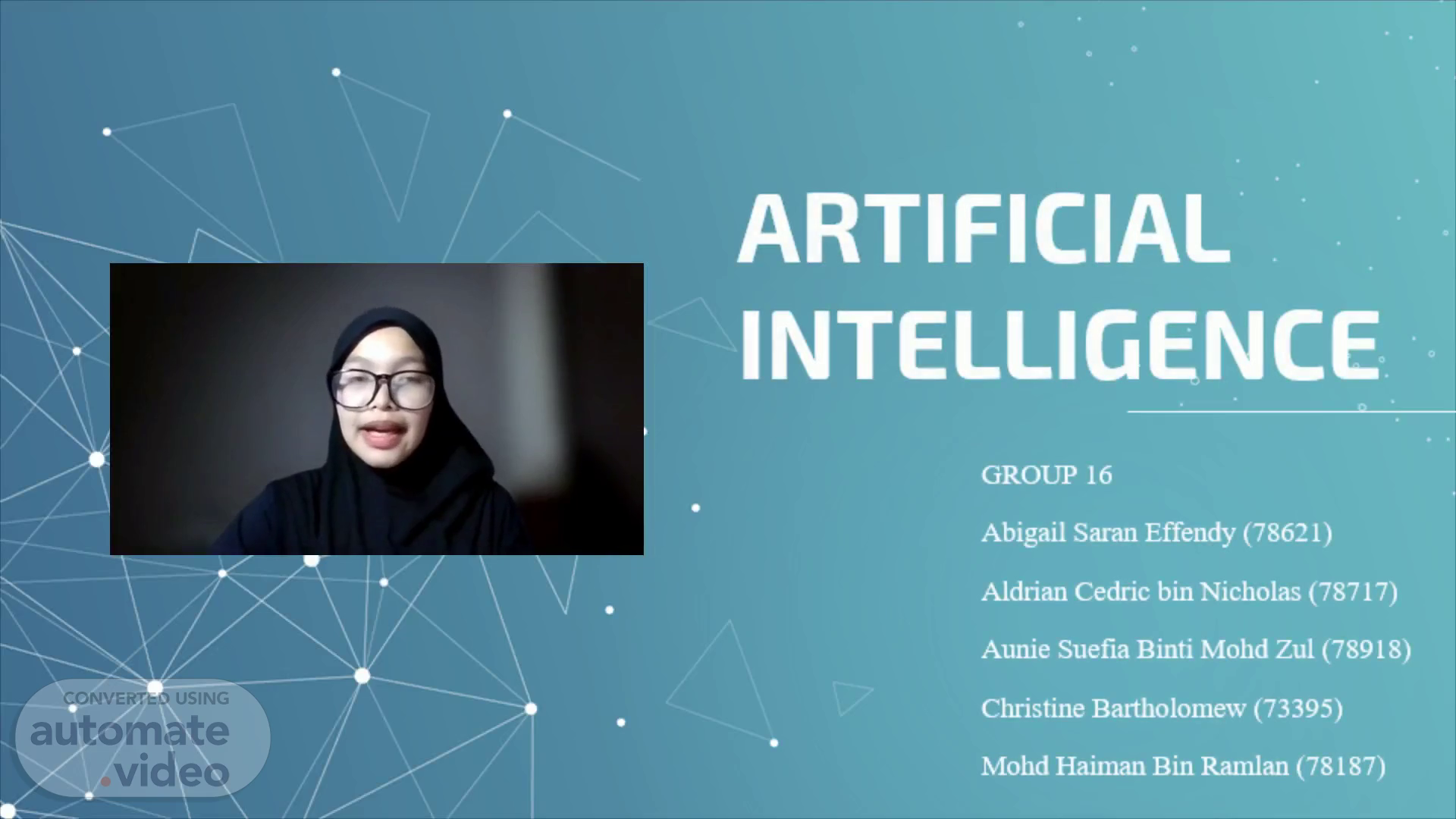
ARTIFICIAL INTELLIGENCE
Scene 1 (0s)
GROUP 16 Abigail Saran Effendy (78621) Aldrian Cedric bin Nicholas (78717) Aunie Suefia Binti Mohd Zul (78918) Christine Bartholomew (73395) Mohd Haiman Bin Ramlan (78187).
Scene 2 (33s)
INTRODUCTION. 1 )Since historical times, humans have conducted experiments to try to better understand the human mind 2)These assessments subsequently result in the improvement of psychology 3)With cognitive techonology ,human is capable of make bigger the concern with laptop techonology to present synthetic intelligenc e.
Scene 3 (1m 36s)
FOR EXAMPLE. 1)Expertise of mind neurons and synapse. -It’s enable increase synthetic neurons in synthetic neural networks..
Scene 4 (2m 26s)
DISCUSSION. brand new and young discipline, combining numerous sciences , theories and techniques including mathematical logic, statistics, probabilities, computational neurobiology and computer science..
Scene 5 (2m 59s)
DEFINITION OF ARTIFICIAL INTELLIGENCE.. The ability of digital computer or computer controlled robot to perform tasks commonly associated with i ntelligent beings . ( Britannica ) an area of computer science that deals with giving machines the ability to seem like they have human intelligence. ( Merriam-Webster dictionary ) the science and engineering of making intelligent machines , especially intelligent computer programs. It is related to similar task of using computers to understand human intelligence, but AI does not have to confine itself to methods that are biologically observable. ( “ What Is Artificial Intelligence ” James McCarthy, 2004 ).
Scene 6 (4m 2s)
FOUR MAIN DISTINCT GOALS OF ARTIFICIAL INTELLIGENCE..
Scene 7 (5m 5s)
Helps humans with things that are beyond human capabilities Enhancing human potential where it acts as a complementary ability to humans To improve human potentials, humans need to be able to adapt to the current progressions and needs..
Scene 8 (5m 37s)
Eg: data analysis - analysing a large dataset that is beyond human capabilities in a shorter time and more accurately (Hazlegreaves, 2019) Eg: ThoughtSpot - a software for data analysis that is easy and fast to use for sorting out data to identify insight to the data..
Scene 9 (6m 20s)
Application on Natural Language Processing (NLP) Uses the power computer programmes that translate words from different languages, responding to verbal instructions and quickly summarise vast amounts of material even instantaneously Acquire knowledge in terms of language and makes some of our daily life activities easier Eg: Apple’s Siri - uses voice recognition then interpret the meaning and gives useful and relatable response..
Scene 10 (7m 9s)
Artificial Intelligence is now being sought by global corporations and a few government agencies, while the rest of the world has yet to fully comprehend its full potential. It is critical to investigate the impact of AI adoption on Human Capital Management in Malaysia due to there has been no research undertaken in Malaysia on the Impact of AI on Human Capital Management. AI status in Malaysia is still in its infancy, but it is a field that is attracting a lot of interest from many authorities..
Scene 11 (8m 9s)
As there hasn't been much research done on this subject, thus the main goal was to help with research and raising awareness. AI is a combination of numerous elements and is not a self-contained system, harnessing its potential necessitates a collaboration of systems and skills. The adaptation of AI usage could considerably improve the efficiency of human capital productivity in this country. Based on the current findings, it can be concluded that AI has its own set of benefits and drawbacks in respect to Human Capital Management..
Scene 12 (8m 51s)
Human capital skills and cognitive capacity have been identified as a vital facilitator since they will aid in the change process and, if ignored, could jeopardise job stability. It's worth noting that AI adoption in any field will fail if the proper skills aren't in place. To unlock the next wave of AI advancement, both supply and demand for AI and data science skills will be critical, necessitating a holistic approach to both teaching future generations of employees and upskilling the existing workforce.
Scene 13 (9m 33s)
CONCLUSION. MACHINE LEARNING AND ARTIFICIAL INTELLIGENCE inventions that are both scientific and mystical both systems that reflect cognitive realities are not new engineering implementation of powerful and long-established cognitive principles.
Scene 14 (10m 1s)
TYPES OF ARTIFICAL INTELLIGENCE. reactive machines, limited memory, theory of mind, and self-awareness reactive machines take in the current environment and organise their actions accordingly, and for limited memory, the machines with limited memory can use recent observations to make intelligent decisions. Machine learning generates systems that also learn from their mistakes by identifying methodologies.
Scene 15 (10m 49s)
ARTIFICIAL INTELLIGENCE IS HELPFUL. technology is better because it can understand the human mind easily These ideas, in particular, would offer a solid understanding of the human condition while also taking into account complicated difficulties..